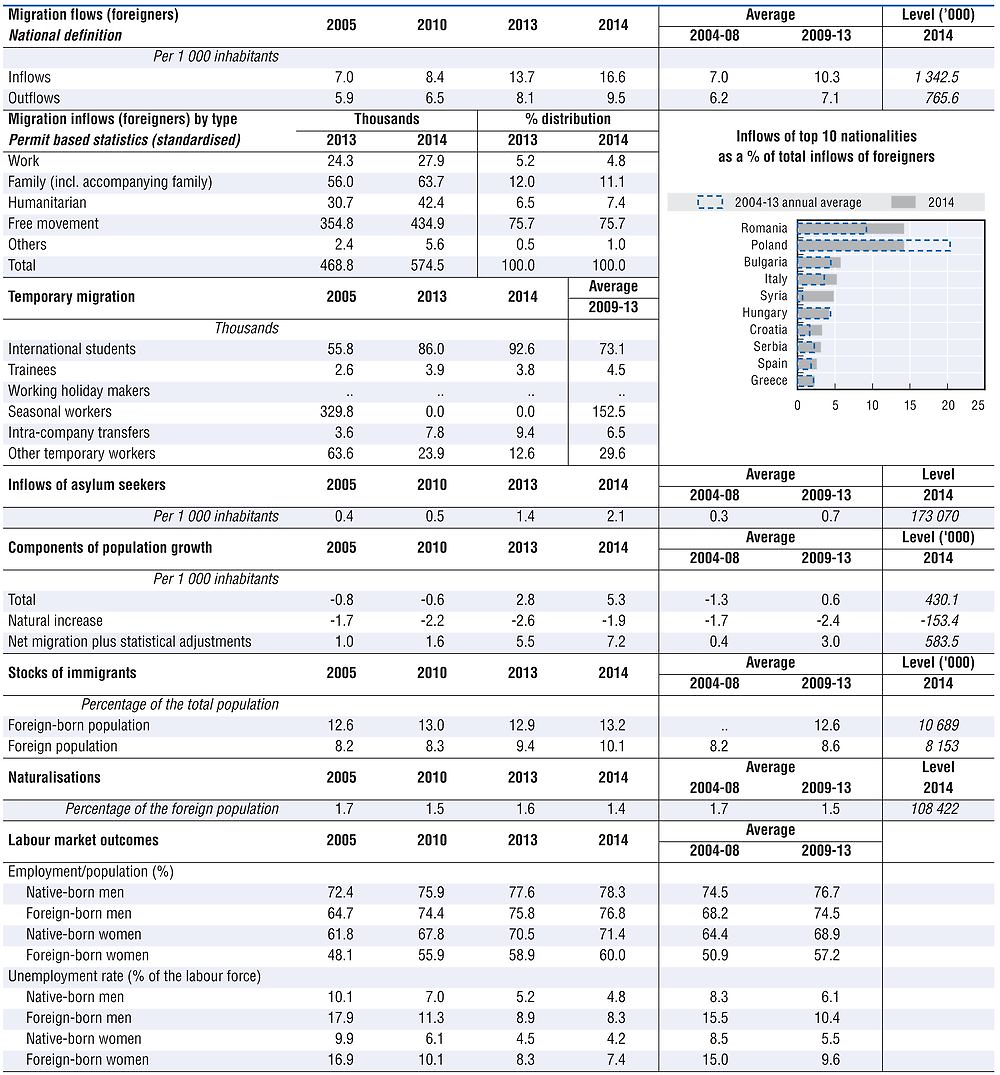Germany
The Federal Statistical Office estimates that net immigration of foreigners (including asylum seekers) reached a record level at 1.1 million in 2015, with almost 2 million entries and 900 000 departures. This is nearly twice the level registered in 2014 (+577 000, 1.3 million entries), which was already the largest migration surplus since 1992. While net immigration of foreigners was largely driven by migratory flows to and from other EU countries until 2014, its composition in 2015 was dominated by the massive inflow of persons seeking asylum in Germany.
In 2015, 1 091 900 persons were registered in the so-called EASY system – an IT system for the pre-registration and first allocation of asylum seekers to initial reception facilities. Applicants for asylum (including dependents) numbered 441 900, representing more than a third of all applications received in the EU28 (Eurostat figures). This constitutes an increase of over 150% compared to 2014 and is the highest ever number of asylum seekers. The top three origins – Syria (159 000, +300%), Albania (54 000, +600%) and Kosovo (33 000, +400%) – accounted for 56% of all applications. The number of Serbian asylum applicants was stable at 17 000, and that of Eritreans down 2 000 at 11 000. Around 56% of decisions made at first instance were positive, compared to 51% in the EU28. Around 176 500 new asylum applications were submitted between January and March 2016 (January-March 2015: 75 000).
In the 2014/15 winter semester, 235 900 non-EEA students – mostly from China (13%), India (5%) and the Russian Federation (5%) – were enrolled at German universities. In 2014, 5 000 residence permits were issued to non-EEA graduates to allow them to find a job following graduation from a German university, compared with 4 500 in 2014.
After labour market restrictions were lifted in 2011 for the countries that joined the EU in 2004, employment of citizens of Central and Eastern European countries increased sharply, from 227 000 persons in April 2011 to 864 700 in June 2015. An EU Blue Card was held by 22 000 foreigners at the end of March 2015, 10 400 of whom worked in shortage occupations and 5 300 of whom had completed their education levels in Germany.
As a response to the large inflow of asylum seekers, Germany adopted a comprehensive legislative package in October 2015, the Act on the Acceleration of Asylum Procedures, Asylverfahrensbeschleunigungsgesetz. It aims to speed up asylum procedures, encourage integration of refugees, and facilitate the deportation of rejected applicants. The package included furnishing financial support to the Länder; providing better access to integration courses and linking courses to job-specific language training; relaxing building regulations for accommodation facilities (for instance, by extending the areas where municipalities and Länder are allowed to build or renovate accommodation dedicated to refugees and asylum seekers); improving assistance to unaccompanied minors; and expanding the list of safe origins to Albania, Kosovo and Montenegro. Serbia, the Former Yugoslav Republic of Macedonia (FYROM) and Bosnia and Herzegovina have been considered safe countries of origin since May 2014, and the number of requests has started to decrease. In addition, asylum seekers and persons from safe countries of origin with a tolerated status who submitted their request after 31 August 2015 are not authorised to work.
The Act has also broadened the access to language and integration courses for asylum seekers with good prospects of remaining – i.e. applicants from Syria, Iran, Iraq and Eritrea; individuals with a tolerated status; and those with a temporary permit on humanitarian grounds who are unable to leave the country for legal or factual reasons. The aim of the integration course is for participants to obtain an adequate level of fluency in the German language and knowledge of Germany’s legal system, culture and history.
In March 2016, a second legislative package entered into force (Asylum Package II, Asylpaket II). It foresees the development of specialised reception centres where decisions on asylum for applicants from safe countries of origin can be made within three weeks. Applicants who appeal first-instance decisions or those who do not co-operate – for instance by submitting false documentation or refusing to have their fingerprints taken – can also be subjected to this accelerated procedure. Furthermore, deportations, which often did not take place due to the poor health status of rejected applicants, can now be enforced unless the migrant is severely ill. In addition, family reunification for humanitarian migrants with subsidiary protection status, including unaccompanied minors, is now only possible after two years.

